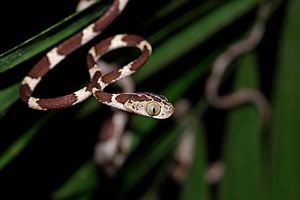Imantodes cenchoa facts for kids
Quick facts for kids Imantodes cenchoa |
|
|---|---|
 |
|
| Conservation status | |
| Scientific classification | |
| Genus: |
Imantodes
|
| Species: |
cenchoa
|
| Synonyms | |
|
|
The blunthead tree snake (scientific name: Imantodes cenchoa) is a type of snake found in Mexico, Central America, and South America. It's also known as the neotropical blunt-headed tree snake or fiddle-string snake. This snake is mildly venomous and has fangs at the back of its mouth. It belongs to the family Colubridae.
Contents
About the Blunthead Tree Snake
The blunthead tree snake is usually about 80 centimeters (31 inches) long. Some can grow up to 1.5 meters (5 feet) long.
This snake is known for its long, thin body and a very large head. Its eyes are also quite special. Most snakes have poor eyesight and use smell or vibrations to find food or avoid danger. But snakes that live in trees, like the blunthead tree snake, have much better vision.
The blunthead tree snake has pupils that look like a vertical slit. This helps the snake see downwards, which is very useful when it's high up in trees. Its large eyes make up about 26% of its head!
Snake Colors and Differences
The blunthead tree snake's belly is mostly white. Its back is a light or pale brown color. It has dark brown patches along its sides, starting from its head and going all the way down its body.
Snakes from different areas can look a bit different. For example, in the northern parts of its range, male blunthead tree snakes have slightly longer tails. But in southern areas, males have shorter tails. This difference between males and females of the same species is called sexual dimorphism. In some places, female snakes also have much larger heads than males.
Where Blunthead Tree Snakes Live
The blunthead tree snake lives in trees, which means it is an arboreal animal. You can often find it in low plants like coffee trees or bromeliads.
It likes places that are cool and wet, such as wet forests and rainforests. These snakes can live anywhere from sea level up to about 1,700 meters (5,600 feet) high.
Geographic Range
I. cenchoa is found in Mexico, most of Central America, and parts of South America. Its range goes as far south as northern Argentina.
It has been seen in many countries, including Guatemala, Honduras, Belize, El Salvador, Nicaragua, Costa Rica, Panama, Colombia, Venezuela, Trinidad and Tobago, French Guiana, Brazil, Ecuador, Peru, Bolivia, and Paraguay.
Blunthead Tree Snake Behavior
The blunthead tree snake is a nocturnal animal, meaning it is active at night. During the day, it rests in a coiled position in very shady spots.
At night, it searches for food. It moves through thick plants, from the ground up into the trees where it rests.
Reproduction and Life Cycle
The blunthead tree snake is a polygynandrous reptile. This means both males and females have multiple partners during the mating season.
The time when these snakes mate can change depending on when the rainy season is in their home. Some snakes mate all year long. But for others, mating happens during the wet and rainy times. For example, in places with long rainy seasons, I. cenchoa will have a longer mating season.
The blunthead tree snake is an oviparous animal. This means it lays eggs, and the baby snakes develop outside the mother's body.
Egg Laying and Hatching
Some blunthead tree snakes reproduce all the time, depending on their environment. However, in areas with seasonal rainfall, egg laying and hatching happen more during the rainy seasons.
For example, in Guatemala and Mexico, female snakes lay their eggs between June and July. These eggs usually hatch around July and August, which are the rainy months there.
In Brazil, however, these snakes lay eggs from November to January. The eggs then hatch from March through August.
Both male and female blunthead tree snakes become old enough to reproduce when they are about two years old. This is usually when they are about 62 centimeters (24 inches) long from their snout to their vent (the opening near the tail).
A female snake can lay one to three eggs in a group, called a "clutch," during each breeding season. The number of eggs depends on the snake's size, what it eats, and its environment. After laying her eggs, the female snake leaves them. She does not take care of her young.
What Blunthead Tree Snakes Eat
The blunthead tree snake is a carnivore, meaning it eats meat. It hunts mostly at night.
It mainly preys on small lizards, like anoles. It also eats frogs and the eggs of reptiles and amphibians. Because female blunthead tree snakes often have larger heads, they can hunt and eat bigger reptiles and amphibians.
The blunthead tree snake has fangs at the back of its mouth and is mildly venomous. However, it is not considered dangerous to humans.
See also
 In Spanish: Mapepire corde violon para niños
In Spanish: Mapepire corde violon para niños


